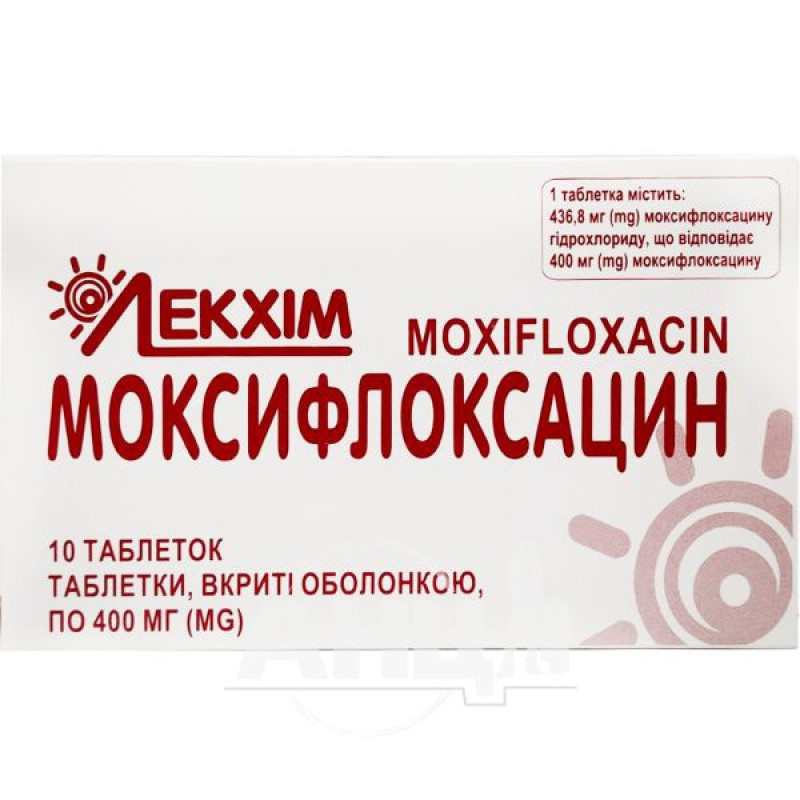Moxifloxacin tablets 400mg No. 10

Moxifloxacin tablets are prescribed for the following indications:
Treatment of the following bacterial infections caused by susceptible microorganisms in patients aged 18 years and older. Moxifloxacin should only be prescribed when antibacterial agents usually recommended for the initial treatment of subsequent infections are inappropriate or when such treatment has failed.
Acute bacterial sinusitis (diagnosed with a high degree of probability). Exacerbation of chronic obstructive pulmonary disease, including bronchitis (diagnosed with a high degree of probability). Community-acquired pneumonia, except for severe community-acquired pneumonia. Mild to moderate pelvic inflammatory disease (including upper genital tract infections in women, including salpingitis and endometritis), not associated with tubo-ovarian abscess or pelvic abscess. Moxifloxacin tablets are not recommended for use as monotherapy in mild to moderate pelvic inflammatory disease, but may be used in combination with other appropriate antibacterial agents (e.g. cephalosporins) due to the increasing resistance of Neisseria gonorrhoeae to moxifloxacin (except for moxifloxacin-resistant strains of N. gonorrhoeae).Moxifloxacin in tablet form can be used to complete a course of treatment in which initial therapy with parenteral moxifloxacin was effective and is prescribed according to the following indications:
community-acquired pneumonia; complicated infections of the skin and subcutaneous structures.Moxifloxacin in tablet form is not recommended for initial treatment of any skin and subcutaneous infections or in severe community-acquired pneumonia.
Attention should be paid to official instructions on the proper use of antibacterial agents.
Composition
Active ingredient: moxifloxacin.
1 tablet contains 436.8 mg of moxifloxacin hydrochloride, which corresponds to 400 mg of moxifloxacin.
Excipients: lactose monohydrate, microcrystalline cellulose, croscarmellose sodium, magnesium stearate, hypromellose, red iron oxide (E 172), macrogol 4000, titanium dioxide (E 171).
Contraindication
Known sensitivity to moxifloxacin or other quinolones, or to any of the excipients of the drug.
Age under 18 years. Pregnancy or breastfeeding. History of tendon diseases associated with quinolone treatment.During preclinical and clinical studies, changes in cardiac electrophysiology in the form of prolongation of the QT interval were observed after the use of moxifloxacin. Therefore, for safety reasons, the drug is contraindicated in patients with:
congenital or diagnosed acquired prolongation of the QT interval; electrolyte imbalance, in particular with uncorrected hypokalemia; clinically significant bradycardia; clinically significant heart failure with reduced left ventricular ejection fraction; symptomatic arrhythmias in history.The drug should not be used concomitantly with other drugs that prolong the QT interval.
Due to limited clinical data, the use of the drug is also contraindicated in patients with impaired liver function (Child-Pugh class C) and patients with elevated transaminase levels (5 times the upper limit of normal).
Method of application
It is recommended to take 1 tablet (400 mg) of moxifloxacin per day.
The tablets should be taken without chewing, with sufficient water. The drug can be taken regardless of the time of meals.
Application features
Pregnant women
Contraindicated.
Children
Moxifloxacin is contraindicated in children (under 18 years of age). The efficacy and safety of moxifloxacin in children have not been established.
Drivers
Patients should be advised to observe their reaction to moxifloxacin before driving or operating machinery.
Overdose
In case of accidental overdose, no specific measures are required. In case of overdose, the clinical picture should be guided and symptomatic supportive therapy and ECG monitoring should be carried out due to the possibility of QT prolongation.
Coadministration of activated charcoal with a 400 mg oral dose of moxifloxacin will reduce the systemic exposure of the drug by more than 80%. In the event of an oral overdose, administration of activated charcoal at the initial stage of absorption may be effective in preventing increased systemic exposure to moxifloxacin.
Side effects
Infectious complications: superinfection resulting from bacterial or fungal resistance, such as oral or vaginal candidiasis.
From the nervous system: headache, dizziness.
Cardiac: QT interval prolongation in patients with hypokalemia.
Gastrointestinal tract: nausea, vomiting, abdominal pain, diarrhea.
Liver and biliary tract: increased transaminase levels.
The use of moxifloxacin in combination with any of the following drugs is contraindicated:
Class IA antiarrhythmics (e.g. quinidine, hydroquinidine, disopyramide); Class III antiarrhythmics (e.g. amiodarone, sotalol, dofetilide, ibutilide); Antipsychotics (e.g. phenothiazines, pimozide, sertindole, haloperidol, sultopride); Tricyclic antidepressants; Some antimicrobials (saquinavir, sparfloxacin, intravenous erythromycin, pentamidine, antimalarials, including halofantrine); Some antihistamines (terfenadine, astemizole, mizolastine); Others (cisapride, vincamine IV, bepridil, diphemanil).Storage conditions
Store in the original packaging at a temperature not exceeding 25 °C.
Keep out of reach of children.
Shelf life - 3 years.
There are no reviews for this product.
There are no reviews for this product, be the first to leave your review.
No questions about this product, be the first and ask your question.
